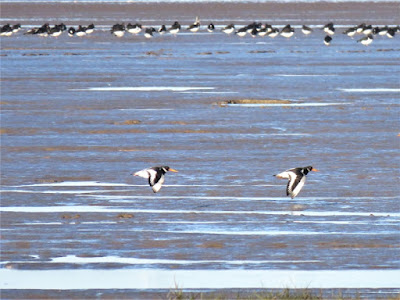I started at Hoylake where it was high tide. Not high-enough to move all the birds off the foreshore. This group of Redshank was resting up while their favoured feeding areas were still covered by the tide.
A trio of waders here with, from the left, a Redshank, an Oystercatcher and a Dunlin.
A better view of a Dunlin (left) with a Redshank.
Here a Redshank alongside an Oystercatcher with a very muddy bill.
An Oystercatcher in search of a meal. The white chin-strap indicates this is a first winter bird.
Oystercatchers can be quarrelsome and noisy birds. Here two square-off.
Over the winter several thousand Oystercatchers gather together when there are the highest of Spring tides. Here two fly-by a distant small gathering.
A Redshank also searches for a meal.
A trio of Redshank on the dropping tide.
I only noted one of these (Common) Ringed Plovers.
The Dee Estuary is a wintering area for many thousand of these Shelducks.
Also gathering along the shore-line are large numbers of Cormorants. Careful examination finds Great Black-backed and Herring Gulls amongst them with six (and a half) Curlews nearer the camera.
In the sand dunes Meadow Pipits can be found. A few breed: these are joined by many that move off the hills after the breeding season.
This is a rather splendid-looking Starling. Field guides tell you that the breast of Starlings are spotted but careful examination shows the pointed breast-feathers have 'V'-shaped white tips.
With a slight turn of its body the green gloss is more evident.
I could find no Red-breasted Mergansers: here are two brownhead Goosanders. This species has been in record numbers of the lake this year.
Two drakes and a brownhead Goosander.
Two of each with one brownhead having a distinctly 'bad-hair' day.
One pontoon was sufficiently far from the workings. On it are a group of Redshanks (at the back) and Turnstones (at the front).
A real brute of an adult winter Herring Gull.



























































